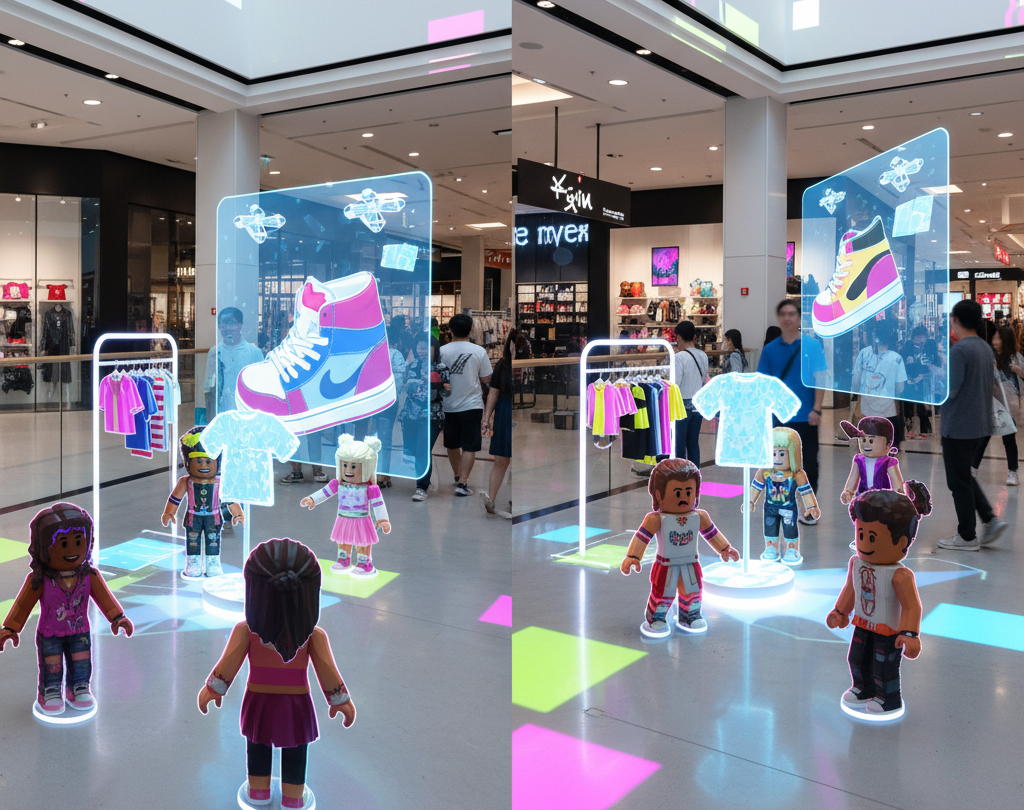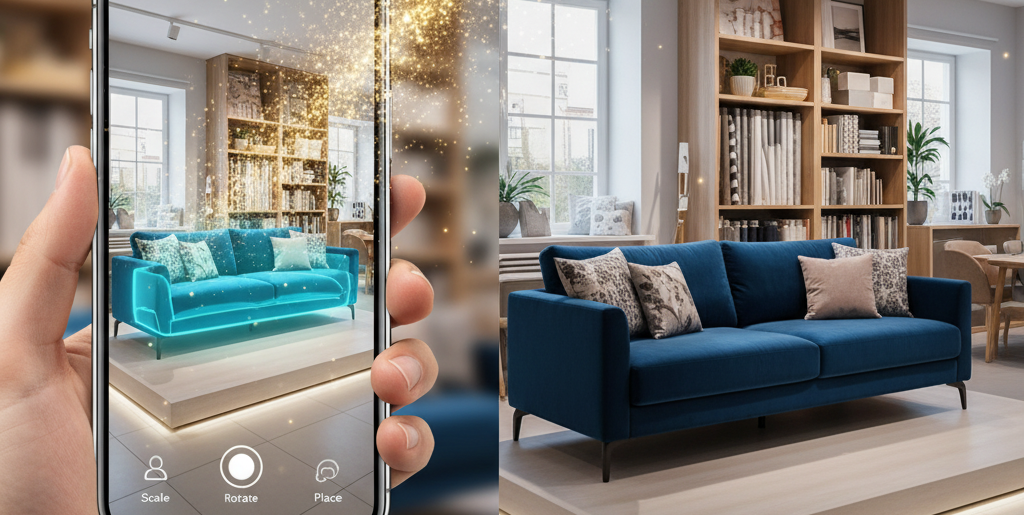The Rise of AR Shopping: How Augmented Reality is Changing Retail Experiences

The lines between physical and digital shopping are disappearing fast. What was once a futuristic concept, trying on clothes virtually or placing a 3D sofa in your living room, is now an expectation. Augmented Reality (AR) isn’t just transforming how consumers shop; it’s redefining what the word shopping even means. From e-commerce experiences that merge convenience with tangibility to in-store AR tools that elevate engagement, the retail industry is witnessing a seismic shift driven by this immersive technology.
How Far In-Store Shopping Has Come
The divide between “online e-commerce” and “brick-and-mortar” is increasingly artificial. Brands like Nike are already blending the two, deploying AR mirrors, QR-code interactive zones and “augmented shoe sizing” in flagship locations.
Meanwhile, iconic retailers such as Victoria’s Secret continue to make headlines: The 2025 Fashion Show headliner, the K-pop group TWICE, reaffirmed how high-profile retail experiences still matter, selling out items in real-time even outside the States.
But the leap ahead is when those runway and showroom moments translate into AR-enabled commerce. Imagine selecting a look on the runway, then using your phone to preview how the outfit looks on you, locate your size in-store, or even view complementary items via AR. This “show and shop” experience is being edged in today’s retail-tech labs and will become mainstream.
For B2B manufacturers, suppliers, or retailers, the takeaway is clear: In-store isn’t a legacy channel; it’s a powerful data-rich touchpoint that lives in synchronization with online, AR, and mobile. The brands scaling fastest are the ones turning in-store into digital-physical hybrids, not isolated silos.
The New Era of AR Shopping
AR bridges the gap between imagination and experience. Traditional online shopping relied on static photos and reviews, leaving much to the buyer’s imagination. AR removes that guesswork by allowing shoppers to interact directly with products in 3D, whether through a smartphone, a headset, or even an in-store digital display.
- Sephora’s Virtual Artist lets customers “try on” makeup products digitally using facial mapping.
- Warby Parker’s virtual try-on allows shoppers to see how different eyeglass frames look in real time.
- IKEA Place enables customers to preview furniture in their own rooms, tackling the long-standing e-commerce challenge of fit and feel.
These brands aren’t just innovating, they’re solving fundamental friction points in the buying process.
Virtual Try-Ons: Personalization at Scale
AR is personalizing shopping like never before. Instead of a one-size-fits-all browsing experience, AR tailors products to individual users in real time. In fashion and beauty, virtual try-ons allow customers to test shades, styles, and fits without setting foot in a store. For retailers, this means higher engagement, fewer returns, and more data on customer preferences.
But here’s the twist: AR isn’t just about convenience, it’s about confidence. Studies show that nearly 60% of the U.S. population is expected to be frequent AR users in 2025, and an overwhelming 90% of American shoppers have either used or are open to using AR when shopping. Even more compelling, 98% of those who have tried AR found it helpful in making purchase decisions. This is no longer a trend; it’s a behavioral shift. And Gen Z is leading the way, with 92% saying they want AR tools for e-commerce, pushing retailers to evolve faster than ever.
AR-Enabled Catalogs and Interactive Store Displays
Remember flipping through a glossy catalog? Today, AR has redefined that tactile nostalgia. AR-enabled catalogs let customers scan images with their phones to see 3D versions of products or watch them come to life through animations. This blend of print and digital gives retailers a new storytelling canvas.
In stores, interactive AR displays are becoming the modern-day salesperson. Imagine walking into a Nike store, pointing your phone at a sneaker, and instantly seeing performance stats, athlete endorsements, and available colorways, no associate needed. This kind of immersive self-service experience challenges the traditional retail model, where information was gated behind salespeople or static displays.
From Roblox to Reality: The Gamification of Shopping
Here’s where AR’s influence gets fascinating: the metaverse. Brands are no longer waiting for shoppers to come to them; they’re meeting consumers where they already play.
Platforms like Roblox and Fortnite have become digital malls of the future, where brands like Gucci, Nike, and Forever 21 host immersive AR-driven experiences.
In Roblox, Gucci built a virtual garden that replicated its Florence exhibition, letting players explore and purchase limited-edition digital items. It wasn’t just a marketing stunt, it drove millions in engagement and opened a new revenue channel for virtual goods.
This gamified, experience-first commerce is what modern consumers, particularly Gen Z, crave. They’re not shopping, they’re participating.
How Important is AR for E-Commerce and Physical Stores?
For e-commerce, AR represents trust and tangibility, two things online shopping traditionally lacked. It bridges the sensory gap by letting consumers see, fit, and feel products digitally.
For physical retail, AR is not a replacement; it’s an evolution. It enhances store discovery, wayfinding, and in-store personalization. Think of Adidas using AR mirrors that display product details or suggest complementary items when a shopper holds a shoe in front of them.
The key value is integration: AR doesn’t replace brick-and-mortar or digital, it unites them into a seamless hybrid model where experience, data, and convenience converge.

How Do We Measure the Impact of AR in Retail?
Like any marketing tool, AR’s success isn’t just about novelty, it’s about measurable outcomes. Key metrics include:
- Engagement time (how long users interact with AR features)
- Conversion rate lift (AR experiences often boost conversions by 20–40%)
- Return rate reduction (because customers make more confident purchases)
- Customer sentiment and shareability (AR campaigns often perform better socially due to their interactive appeal)
Retailers can also track AR interactions across platforms, Snapchat lenses, Instagram AR filters, and in-app virtual try-ons, to determine which channel drives the most engagement.
Challenging Traditional Marketing
Traditional retail marketing focused on visibility and persuasion. AR shifts the focus to interaction and immersion. In the old model, marketing was about telling a story. In the AR era, it’s about letting consumers live the story. This requires brands to rethink not just their campaigns, but their entire customer journey, from product design to purchase behavior.
The challenge now is not getting attention; it’s earning participation. AR achieves this by turning shopping into a co-created experience, where consumers play, explore, and personalize in real-time.
Augmented Reality Brings More Opportunities for Data Insights
While it may be tempting to say that AR is simply about creating immersive experiences, the real value for brands lies in the rich insights AR shopping environments generate. When a shopper uses an AR tool to try on a product, explore options, or engage with an in-store display, the brand is learning far more than just “the product was viewed.” These interactions offer signals about preferences, behaviors, decision momentum, and purchase intent.
- How long does a user linger on a certain 3D product render?
- Which color or style variations do they preview in AR?
- How many try-on attempts before moving to checkout?
- Whether the AR session converts into a request for a demo, a reservation, or a purchase.
From a B2B perspective, that means your AR-enabled catalog or in-store experience becomes more than just a “cool tool”; it becomes a diagnostic layer in your buyer journey. Instead of relying only on generic click-rates or views, you can map AR engagements to pipeline signals: users who engage with AR are often further down the funnel, more decision-ready, and more receptive to follow-up. In short: the future of AR shopping isn’t just “experience for the customer”, it’s “experience as insight for your business.”
The Future of AR in Retail
AR is not a gimmick; it’s the future of retail engagement. It bridges e-commerce and physical shopping into one cohesive experience, making every interaction more personal, efficient, and memorable. As digital natives continue to dominate the consumer base, the brands that thrive will be those that make technology invisible and experience unforgettable.
From Sephora’s virtual makeovers to Gucci’s virtual gardens in Roblox, the message is clear: AR isn’t just changing how we shop, it’s changing why we shop. The future of retail belongs to the brands that understand this new equation: experience and immersion is loyalty.